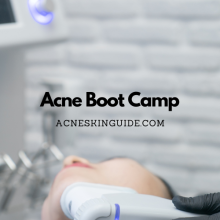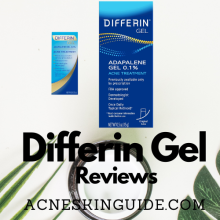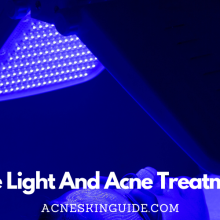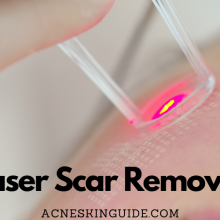Differin vs Tretinoin | Acne Skin Guide
The article compares two popular retinoid treatments, Differin (adapalene) and Tretinoin (retinoic acid), for addressing acne and signs of aging. As vitamin A derivatives, both help regulate skin cell turnover to unclog pores and stimulate collagen production. Differin gel is an over-the-counter option effective for mild to moderate acne with gradual anti-aging benefits.
Tretinoin is the prescription-strength gold standard, potently treating severe acne while providing more dramatic anti-wrinkle results, but with higher risk of irritation. The choice depends on individual concerns and tolerance levels. Many dermatologists recommend starting with Differin first, then potentially transitioning to tretinoin if needed. With proper usage and patience, either retinoid can improve acne and reveal a smoother, more youthful complexion over time.
#1 Recommended Acne Treatment | #2 Recommended Acne Treatment |
 |  |

The Quest for Clear, Youthful Skin: Differin vs Tretinoin for Acne and Wrinkles
For those plagued by acne and signs of aging, finding an effective skincare solution can feel like an endless battle. However, two powerhouse retinoid treatments, Differin and Tretinoin, have emerged as game-changers in the quest for clear, youthful skin. But which one reigns supreme? Let’s delve into the pros and cons of each.
What are Retinoids?
Retinoids are vitamin A derivatives that have been hailed as skincare superheroes for their ability to regulate cell turnover and combat various skin concerns. They work by increasing skin cell shedding, unclogging pores, and stimulating collagen production, resulting in a smoother, more radiant complexion.
Meet Differin (Adapalene)
Differin, also known as adapalene, is a synthetic retinoid that has revolutionized the over-the-counter skincare market. Available in a 0.1% gel or cream formulation, Differin gained FDA approval in 2016 as the first new acne-fighting ingredient to hit drugstore shelves in over 30 years.
The Differin Advantage:
- Accessible and affordable without a prescription
- Effective in treating mild to moderate acne, including whiteheads, blackheads, and clogged pores
- Gradually improves skin texture and fine lines with consistent use
- Generally well-tolerated, with fewer reported side effects than prescription retinoids
The Potential Downsides:
- May be less potent than prescription-strength retinoids for severe acne or advanced signs of aging
- Can still cause dryness, redness, and peeling, especially during the initial “retinization” period
Enter Tretinoin (Retinoic Acid)
Tretinoin, also known as retinoic acid, is a prescription-strength retinoid that has been a dermatologist’s go-to for decades. Available in various strengths (typically 0.025% to 0.1%) and formulations (cream, gel, or solution), tretinoin is considered the gold standard for treating acne and addressing signs of aging.
The Tretinoin Advantage:
- Proven efficacy in treating all severities of acne, from mild to severe cases
- Potent anti-aging properties, visibly reducing fine lines, wrinkles, and uneven skin tone
- Extensive research and clinical studies backing its effectiveness
- Can be combined with other prescription acne treatments for enhanced results
The Potential Downsides:
- Requires a prescription and may be costlier, depending on insurance coverage
- Increased risk of side effects like dryness, peeling, and irritation, especially with higher strengths
- Potential for increased sun sensitivity and risk of degradation due to light exposure
The Acne Battle: Differin vs Tretinoin
When it comes to acne treatment, both Differin and Tretinoin have proven their worth. Differin gel has been shown to effectively target different types of acne lesions, including whiteheads, blackheads, and clogged pores. Meanwhile, tretinoin has a long-standing reputation for treating all severities of acne, from mild to severe cases.
While head-to-head studies have found similar efficacy between the two retinoids over time, tretinoin may have a slight edge in terms of initial speed of action. However, Differin’s generally better tolerability and accessibility make it an excellent first-line option, especially for those with mild to moderate acne.
The Anti-Aging Showdown
In the realm of anti-aging, tretinoin has long been a dermatologist’s weapon of choice. Its potent ability to stimulate collagen production and improve skin texture has earned it a well-deserved reputation for visibly reducing fine lines, wrinkles, and uneven skin tone.
While Differin may not pack the same anti-aging punch as tretinoin, it can still gradually improve skin texture and minimize fine lines with consistent use. Combining either retinoid with other antioxidants like vitamin C can further enhance their anti-aging benefits.
Managing Side Effects
One of the biggest challenges with retinoid use is managing the potential side effects, which can include dryness, redness, peeling, and general irritation. This is particularly true during the initial “retinization” period as the skin adjusts to the increased cell turnover.
To minimize these side effects, it’s crucial to start slow and gradually introduce the retinoid into your routine. For Differin, once-daily application is generally well-tolerated, while tretinoin should be introduced 2-3 times per week and slowly increased as tolerated.
Incorporating a gentle, non-irritating skincare routine and using moisturizers can also help mitigate dryness and irritation. Additionally, adjusting the frequency of use based on seasonal changes or climate can help maintain comfortable skin.
Cost and Access Considerations
One of the primary advantages of Differin is its accessibility and affordability. As an over-the-counter product, it typically costs between $10 and $15 for a 1-3 month supply, making it a budget-friendly option for many.
In contrast, tretinoin requires a prescription, and its cost can vary depending on the strength, formulation, and insurance coverage. Some dermatologists may recommend starting with OTC Differin first before transitioning to prescription tretinoin if needed.
Special Considerations
It’s important to note that tretinoin products tend to degrade faster when exposed to light and air compared to Differin, which can affect their potency over time. Additionally, retinoids in general should be used cautiously during pregnancy due to potential risks.
Regarding age recommendations, tretinoin may be more suitable for adult patients, while Differin can be an appropriate first retinoid for teenagers and young adults with acne concerns.
The Verdict: Finding the Right Fit
The choice between Differin and Tretinoin ultimately comes down to individual skin concerns, goals, and tolerance levels. For those seeking an accessible and generally well-tolerated option for mild to moderate acne and gradual anti-aging benefits, Differin gel can be an excellent starting point.
However, for more severe acne or advanced signs of aging, prescription tretinoin may be the more potent solution, provided the skin can build sufficient tolerance to manage potential side effects.
Many dermatologists recommend a stepwise approach, starting with over-the-counter Differin and transitioning to prescription tretinoin if needed for more significant results. This strategy allows individuals to gauge their skin’s response and build tolerance before advancing to a stronger retinoid.
Regardless of the choice, consistency and patience are key when using retinoids. With proper guidance and a tailored skincare routine, both Differin and Tretinoin can pave the way to clearer, more youthful-looking skin.
#1 Recommended Acne Treatment | #2 Recommended Acne Treatment |
 |  |
Summary and FAQs
Can Differin and Tretinoin be used together?
Yes, Differin (adapalene) and Tretinoin can potentially be used together, but it’s generally not recommended to apply them at the same time due to the increased risk of irritation. Here are some tips on using them together:
- Separate application times: It’s best to apply Differin and Tretinoin at different times of the day, like Differin in the morning and Tretinoin at night. This allows your skin to adjust to one retinoid at a time.
- Introduce them slowly: Start with one retinoid first (either Differin or Tretinoin) and use it for several weeks until your skin builds some tolerance. Then, slowly introduce the second retinoid a few times a week while monitoring for any excessive dryness or irritation.
- Adjust strengths: If using both together causes too much irritation, you may need to use a lower strength of one product, like 0.025% Tretinoin instead of 0.1%.
- Buffer with moisturizer: Apply a fragrance-free, gentle moisturizer in between the two retinoid products to act as a buffer and reduce irritation.
- Take a break: If your skin becomes overly dry or irritated, stop using one or both products temporarily until your skin calms down.
It’s generally advisable to consult with a dermatologist before attempting to use Differin and Tretinoin together, as they can provide personalized guidance based on your skin type and concerns. Proper precautions are necessary to avoid excessive irritation or damage to the skin barrier.
How long does it take to see results from Differin vs Tretinoin?
The time it takes to see noticeable results can vary between Differin (adapalene) and Tretinoin, as well as differ for treating acne versus anti-aging concerns. Here’s a general timeline for each:
For Acne:
Differin (Adapalene 0.1% Gel):
- You may start to see some improvement in acne within 4-8 weeks of consistent use.
- More significant clearing can take 12 weeks or longer.
- During the first few weeks, you may experience a “purge” with more blemishes before it gets better.
Tretinoin:
- You may notice an initial flare-up of acne within the first 4-6 weeks (tretinoin purge).
- Improvement in acne lesions can start as early as 6-8 weeks with consistent use.
- More dramatic results are typically seen after 12 weeks of treatment.
- Higher strengths like 0.1% tretinoin may work faster than lower 0.025% strengths.
For Anti-Aging:
Differin (Adapalene):
- You’ll likely start to see a smoother skin texture within 3-6 months of regular use.
- Reduction in fine lines and wrinkles can take 6-12 months of consistent application.
Tretinoin:
- Improvement in skin tone and reduction of fine lines can be visible in 6-12 weeks.
- More significant wrinkle reduction and increased collagen production may take 6-12 months.
- Higher tretinoin strengths tend to show faster anti-aging results compared to lower strengths.
It’s important to use both products consistently as instructed and be patient, as retinoids can take several months to provide their full effects, especially for anti-aging. Sticking with the treatment and letting it work is key to achieving optimal results over time.
Are there any differences in how Differin and Tretinoin should be applied?
Yes, there are some differences in how Differin (adapalene) and Tretinoin should be applied for best results:
Differin (Adapalene Gel 0.1%) Application:
- Can be applied once daily, either morning or evening
- Should be applied to clean, dry skin after cleansing
- Use a pea-sized amount for the entire face
- Can be applied under or over moisturizer
- No specific wait times required before/after applying
Tretinoin Application:
- Should only be applied once daily before bedtime
- Apply to clean, dry skin 20-30 minutes after cleansing and toning
- Use just a pea-sized amount to cover the entire face
- Let it fully absorb for 20-30 minutes before applying moisturizer
- Start by applying every 2-3 days, then work up to daily use as tolerated
- Buffer with a moisturizer to reduce irritation when starting
Other Differences:
- Tretinoin degrades with exposure to light/air, so should be stored properly
- Tretinoin increases sun sensitivity, so sun protection is crucial
- Differin is more gentle for first-time retinoid users
- Tretinoin requires working up to the higher prescription strengths gradually
Following the specific application instructions for each retinoid is important for maximizing results while minimizing potential irritation. With tretinoin especially, taking it slow with frequency and buffering with moisturizer can help the skin adjust. Proper usage techniques will vary somewhat between these two retinoids.
Can you use Differin/Tretinoin around the eye area?
While Differin (adapalene) and Tretinoin can be effective for treating acne and signs of aging on the face, they should be used with caution around the sensitive eye area. Here are some guidelines:
Differin (Adapalene 0.1% Gel):
- Can potentially be used around the orbital eye area (bone surrounding the eyes) in small amounts to treat fine lines.
- However, it’s best to avoid applying it too close to the eyes or on the eyelids themselves, as it may cause irritation.
- Start by applying a pea-sized amount on the orbital bone only, keeping it at least a finger-width away from the actual eyes.
Tretinoin:
- Most dermatologists advise against using tretinoin creams/gels in the eye area due to the higher risk of irritation.
- The eye area skin is very thin and delicate, so tretinoin may be too harsh, potentially causing dryness, redness, and discomfort.
- Some tretinoin formulations like the cream may migrate into the eyes more easily and cause stinging.
For Both Products:
- Never apply directly on the eyelids or directly next to the eyes/tear ducts.
- If using around the orbital eye area, apply an extra fragrance-free eye cream/moisturizer on the eyelids to protect that area.
- Stop use and rinse thoroughly if you experience excessive dryness, burning, or irritation around the eyes.
- Consider using a dedicated eye cream with gentler anti-aging ingredients for the eye area instead.
While retinoids can help minimize crow’s feet over time, caution is advised when using them in close proximity to the eyes. Stick to the orbital area only and introduce small amounts slowly to gauge your tolerance. Consulting a dermatologist is recommended before applying these potent products around the eyes.
How do Differin and Tretinoin compare to retinol or other retinoids?
When comparing Differin (adapalene) and Tretinoin to retinol and other retinoids, there are some key differences:
Retinol:
- Retinol is a vitamin A derivative that is converted to retinoic acid (the active form) within the skin.
- It is generally less potent and more gentle than prescription retinoids like Tretinoin.
- Results from retinol tend to be more gradual compared to prescription retinoids.
- Retinol is available over-the-counter and may cause less irritation than stronger retinoids.
Tazarotene:
- Tazarotene is a prescription retinoid that is often considered the most potent option.
- It may be more effective than Tretinoin for treating acne and signs of aging.
- However, Tazarotene also tends to cause more dryness and irritation.
- It is usually recommended for patients who don’t see desired results from Tretinoin.
Trifarotene:
- Trifarotene is a newer, synthetic retinoid approved for treating acne.
- Early studies suggest it may be as effective as Tretinoin for acne with potentially fewer irritating effects.
- Limited long-term data on its anti-aging benefits compared to other retinoids.
In general, Differin (adapalene) is considered a gentle, well-tolerated retinoid option that is suitable as a first retinoid for many people. Tretinoin is a more potent prescription retinoid that may provide faster results but has a higher risk of irritation, especially at higher strengths.
Retinol is less potent but also less irritating than prescription retinoids. Stronger options like Tazarotene are reserved for cases that don’t respond to Tretinoin or require more aggressive treatment.
The choice depends on an individual’s skin concerns, tolerance levels, and treatment goals. Many dermatologists recommend starting with a gentle retinoid like Differin or retinol before potentially moving up to prescription retinoids if needed.






